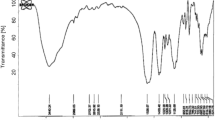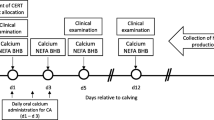Abstract
Two experiments were carried out in order to evaluate the efficacy of a partially decreased dietary cation-anion difference (pDCAD) of dry period rations of dairy cattle ((DCAD ~ 0 mEq/Kg DM) in prevention of postpartum subclinical hypocalcemia (SCH). The primary goal of the Experiment I was to compare the efficacy of a pDCAD strategy in minimizing SCH against a full DCAD (fDCAD ~ − 50 mEq/Kg DM) and a low calcium diet (LCD) in late (21 days (d)) pregnancy in Farm 1, using 66 multiparous cows (parity ≥ 3). The primary goal of Experiment II was to evaluate the effect of extension of a pDCAD to whole dry period (expDCAD-60 days), enrolling 40 cows (parity ≥ 3) to compare a pDCAD vs. expDCAD strategy. In both experiments, a primiparous heifers group was included as well. Serum Ca, Pi, Mg, and energy status indicators β-hydroxybutyrate (BHB) and non-esterified fatty acids (NEFA) were monitored pre- and post-partum, serially. Experiment I showed a significantly lower Ca, a numerically higher prevalence of SCH, and significantly lower NEFA and BHB in pDCAD vs. fDCAD. The prevalence of subclinical ketosis (SCK) was significantly higher in fDCAD peripartally. In Experiment II, a significantly higher Ca and lower prevalence of SCH were observed in expDCAD vs. pDCAD postpartum, while BHB, NEFA, and the prevalence of SCK were not significantly different. The prevalence of SCH in primiparous heifers in both experiments was about 30%. Overall, compared to common ordinary fDCAD strategy, pDCAD could be potentially regarded as a practical intervention, when the adverse effects of fDCAD are unavoidable.






Similar content being viewed by others
References
Block E (1984) Manipulating dietary anions and cations for prepartum dairy cows to reduce incidence of milk fever. J Dairy Sci 67(12):2939–2948
Charbonneau E, Pellerin D, Oetzel GR (2006) Impact of lowering cation-anion difference in nonlactating dairy cow: a meta-analysis. J Dairy Sci 89(2):537–548
Collier RJ, Annen EL, Fitzgerald AC (2004) Prospects for zero days dry. Vet Clin North Am Food Anim Pract 20(3):687–701
Constable PD (2014a) Acid-base assessment when and how to apply the Henderson-Hasselbalch equation and strong ion difference theory. Vet Clin Food Anim 30:295–316
Constable PD (2014b) Treatment and control of periparturient hypocalcemia in dairy cattle. proceedings of the28th World Buiatrics Congress, Carins 59-63.
Curtis CR, Erb HN, Sniffen CJ, Smith RD, Powers PA, Smith MC, White RB, Hillman RB, Pearson EJ (1983) Association between parturient hypocalcaemia with eight periparturient disorders in Holstein cows. J Am Vet Med Assoc 183(5):559–561
Curtis CR, Erb HN, Sniffen CJ, Smith RD (1984) Epidemiology of parturient paresis: predisposing factors with emphasis on dry cow feeding and management. J Dairy Sci 67(4):817–825
DeGaris PJ, Lean IJ (2008) Milk fever in dairy cows: a review of pathophysiology and control principles. Vet J 176(1):58–69
Dishington IW (1975) Prevention of milk fever (hypocalcemic paresis puerperalis) by dietary salt supplements. Acta Vet Scand 16(4):503–512
Goff JP (2000) Pathophysiology of calcium and phosphorus disorders. Vet Clin North Am Food Anim Pract 16(2):319-337
Goff JP (2004) Macromineral disorders of the transition cow. Vet Clin North Am Food Anim Pract 20(3):471–494
Goff JP (2008) Monitoring, prevention, and treatment of milk fever and subclinical hypocalcemia in dairy cows. Vet J 176(1):50–57
Goff JP (2016) Overview of metabolic disease: impact of energy, protein and mineral issues on health and immunity of the periparturient cow. proceedings ofthe 29th World Buiatrics Congress, Dublin, Ireland 60-65.
Goff JP, Horst RL (1997) Effects of the addition of potassium or sodium, but not calcium, to prepartum rations on milk fever in dairy cows. J Dairy Sci 80(1):176–186
Goff JP, Horst RL (1998) Use of hydrochloric acid as a source of anions for prevention of milk fever. J Dairy Sci 81(11):2874–2880
Goff JP, Liesegang A, Horst RL (2014) Diet-induced pseudohypoparathyroidism: a hypocalcemia and milk fever risk factor. J Dairy Sci 97(3):1520–1528
Grünberg W, Donkin SS, Constable PD (2011) Periparturient effects of feeding a low dietary cation-anion difference diet on acid-base, calcium, and phosphorus homeostasis and on intravenous glucose tolerance test in high-producing dairy cows. J Dairy Sci 94(2):727–745
Horst RL, Goff JP, Reinhardt TA, Buxton DR (1997) Strategies for preventing milk fever in dairy cattle. J Dairy Sci 80(7):1269–1280
Joyce PW, Sanchez WK, Goff JP (1997) Effect of anionic salts in prepartum diets based on alfalfa. J Dairy Sci 80(11):2866–2875
Kimura K, Reinhardt TA, Goff JP (2006) Parturition and hypocalcemia blunts calcium signals in immune cells of dairy cattle. J Dairy Sci 89(7):2588–2595
Lake G (1971) Twenty-year review of the dairy industry in the United States: developments, problems, and possible solutions. J Dairy Sci 54(11):1708–1713
Lean IJ, DeGaris PJ, McNeil DM, Block E (2006) Hypocalcemia in dairy cows: Meta-analysis and dietary cation anion difference theory revisited. J Dairy Sci 89(2):669–684
LeBlanc S (2010) Assessing the association of the level of milk production with reproductive performance in dairy cattle. J Reprod Develop 56:1–7
LeBlanc SJ, Leslie KE, Duffield TF (2005) Metabolic predictors of displaced abomasum in dairy cattle. J Dairy Sci 88(1):159–170
Martinez N, Risco CA, Lima FS, Bisinotto RS, Greco LF, Ribeiro ES, Maunsell F, Galvão K, Santos JEP (2012) Evaluation of peripartal calcium status, energetic profile, and neutrophil function in dairy cows at low or high risk of developing uterine disease. J Dairy Sci 95(12):7158–7172
Martin-Tereso J, Martens H (2014) Calcium and magnesium physiology and nutrition in relation to the prevention of milk fever and tetany (dietary management of macrominerals in preventing disease). Vet Clin North Am Food Anim Pract 30(3):643–670
Massey CD, Wang C, Donovan GA, Beede DK (1993) Hypocalcaemia at parturition as a risk factor for left displacement of the abomasum in dairy cows. J Am Vet Med Assoc 203(6):852–853
Moore SJ, Vandehaar MJ, Sharma BK, Pilbeam TE, Beede DK, Bucholtz HF, Liesman JS, Horst RL, Goff JP (2000) Effects of altering dietary cation-anion difference on calcium and energy metabolism in peripartum cows. J Dairy Sci 83(9):2095–2104
Murray RD, Horsfield JE, McCormick WD, Williams HJ, Ward D (2008) Historical and current perspectives on the treatment, control and pathogenesis of milk fever in dairy cattle. Vet Rec 163(19):561–565
National Research Council (2001) Nutrient requirements of dairy cattle. 7th rev ed Nat Acad Sci. Washington DC.
Oetzel GR (1991) Meta-analysis of nutritional risk factors for milk fever in dairy cattle. J Dairy Sci 74(11):3900–3912
Oetzel GR (2000) Management of dry cows for the prevention of milk fever and other mineral disorders. Vet Clin North Am Food Anim Pract 16(2):369–386
Oetzel GR (2004) Monitoring and testing dairy herds for metabolic disease. Vet Clin North Am Food Anim Pract 20(3):651–674
Oetzel GR, Olson JD, Curtis CR, Fettman MJ (1988) Ammonium chloride and ammonium sulphate for prevention of parturient paresis in dairy cows. J Dairy Sci 71(12):3302–3309
Overton TR, Waldron MR (2004) Nutritional management of transition dairy cows: strategies to optimize metabolic health. J Dairy Sci 87:105–119
Reinhardt TA, Lippolis JD, McCluskey BJ, Goff JP, Horst RL (2011) Prevalence of subclinical hypocalcemia in dairy herds. Vet J 188(1):122–124
Seifi HA, Mohri M, Kalamati Zadeh J (2004) Use of pre-partum urine pH to predict the risk of milk fever in dairy cows. Vet J 167(3):281–285
Thilsing-Hansen T, Jorgrnsen R (2001) prevention of parturient paresis and subclinical hypocalcemia in dairy cows by zeolite A administration in the dry period. J Dairy Sci 84(3):691–693
Thilsing-Hansen T, Jørgensen RJ, Østergaard S (2002) Milk fever control principles: a review. Acta Vet Scand 43(1):1–19
VandeHaar MJ, St-Pierre N (2006) Major advances in nutrition: relevance to the sustainability of the dairy industry. J Dairy Sci 89(4):1280–1291
Weich W, Block E, Litherland NB (2013) Extended negative dietary cation-anion difference feeding does not negatively affect postpartum performance of multiparous dairy cows. J Dairy Sci 96(9):5780–5792
Wu Z, Bernard JK, Zanzalari KP, Chapman JD (2014) Effect of feeding a negative dietary cation-anion difference diet for an extended time prepartum on postpartum serum and urine metabolites and performance. J Dairy Sci 97(11):7133-7143
Acknowledgments
We wish to thank Mr. M.H.Musazadeh and Mr. A. Abbasi, who let us run the present studies in their farms.
Funding
This project was approved and financially supported by the Dean for Research of the Ferdowsi University of Mashhad (Approval code 3/38409 session 494/18-05-94), Mashhad, IRAN.
Author information
Authors and Affiliations
Corresponding author
Ethics declarations
Conflict of interest
The authors declare that they have no conflicts of interest.
Ethical approval
The experiments were approved by the Committee for Animal Welfare at the School of Veterinary Medicine, Ferdowsi University of Mashhad, Mashhad, Iran.
Additional information
Publisher’s note
Springer Nature remains neutral with regard to jurisdictional claims in published maps and institutional affiliations.
Rights and permissions
About this article
Cite this article
Norouzi, B., Hanifi, M., Teymouri, F. et al. Comparative study of “partial dietary cation-anion difference” strategy as a nutritional intervention for preventing subclinical hypocalcemia in dairy cattle. Comp Clin Pathol 29, 411–423 (2020). https://doi.org/10.1007/s00580-019-03069-9
Received:
Accepted:
Published:
Issue Date:
DOI: https://doi.org/10.1007/s00580-019-03069-9




